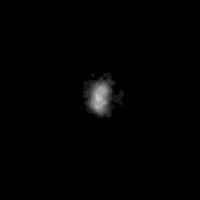Nereid (satellite)
Nereid (from the Greek, Νηρηΐδα) is a natural satellite of Neptune, the third largest. It was discovered by Gerard Kuiper in 1949. Its orbit is highly elliptical, so it could be a captured object. Hardly any details of its surface are known. In 1989, when the space probe Voyager 2 flew over the Neptune system, it passed very far from this satellite.
More information
Nereid was discovered in 1949 by astronomer Gerard Kuiper. Nereid is nearly 210 miles (340 kilometers) in diameter and so far from Neptune that it requires 360 days to orbit. Voyager's best photos of Nereid were taken at nearly 4.7 million kilometers (2.9 million miles). The photos show that the moon's surface reflects nearly 14 percent of the sunlight it receives, making it slightly more reflective than Earth's moon, and more than twice as reflective as Proteus. Nereid's orbit is the most eccentric in the solar system. Its distance from Neptune ranges from nearly 1,353,600 kilometers (841,100 miles) to 9,623,700 kilometers (5,980,200 miles).
Discovery and naming
Nereid was discovered on May 1, 1949 by the Dutch-American astronomer Gerard Kuiper in photographic plates taken by the 82-inch telescope at McDonald Observatory. It gets its name from the Nereids, the sea nymphs in Greek mythology. Kuiper himself proposed it in the discovery paper. It was the second and last satellite of Neptune discovered before the arrival of Voyager 2—not counting a single occultation of Larissa in 1981.
Orbital parameters and rotation
Nereid orbits Neptune in a direct direction at an average distance of 5 513 818 km, but due to its high eccentricity—around 0.7507 — comes as close as 1,353,600 km and as far as 9,623,700 km. This unusual orbit suggests that it is either a captured Kuiper belt object or an inner satellite that was perturbed during Triton's capture. Until 2003, the date of Psamate's discovery, it was the system's outermost satellite. neptunian.
In 1991, a team of astronomers determined by analyzing its light curve a rotation period of 13.6 hours. Another work in 2003 calculated that period at 11.52 hours. However, these calculations have been been called into question, as subsequent researchers have been unable to detect any periodic modulation in the Nereid light curve.
Physical characteristics
Nereid is the third largest satellite of Neptune and has a mean diameter of 340 km, which is quite large for an irregular satellite. Nereid's precise shape is unknown.
Since 1987, several photometric observations of the Nereid have detected large variations in brightness—of about one magnitude—that occur over years or months, but sometimes also within a few days. These variations persist even after correcting for the effects of phase and distance. On the other hand, not all astronomers who have observed the Nereid have noticed such variations. This means that these variations can be quite chaotic. So far there is no convincing explanation for the variations which, if they exist, are probably related to the satellite's rotation. Due to the high eccentricity of its orbit, Nereid can be both in a state of forced precession and have chaotic rotation (like Hyperion). In any case, its rotation should be quite irregular.
In spectral data, Nereid appears neutral in color and surface water ice has been detected. Its spectrum appears to be intermediate between those of the uranian satellites Titania and Umbriel, suggesting that Nereid's surface is It's made up of a mixture of water ice and some spectrally neutral material. The spectrum is very different from that of minor bodies in the outer solar system—such as the centaurs Pholus, Chiron, and Chariclo—suggesting that the Nereid formed around Neptune rather than a captured body.
Halimede, which is similar in color, could be a fragment of Nereid that broke off after a collision.
Space exploration
The only spacecraft to have visited Nereid is Voyager 2, between April 20 and August 19, 1989, which passed within an arc of distances between 9,200,000 km and 176 million kilometers and obtained 83 photographs with an accuracy between 70 km and 800 km. Before the arrival of Voyager 2, observation of Nereid had been limited to observations from the Earth's surface, which could only establish its intrinsic brightness and orbital elements. Although the images obtained by the space probe did not have sufficient resolution to resolve surface features, they allowed us to measure the size of Nereid and determine that it is gray in color and that its albedo is greater than that of other small satellites of Neptune.
Contenido relacionado
(143)
Claudius Ptolemy
Astrophysics
